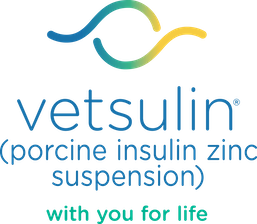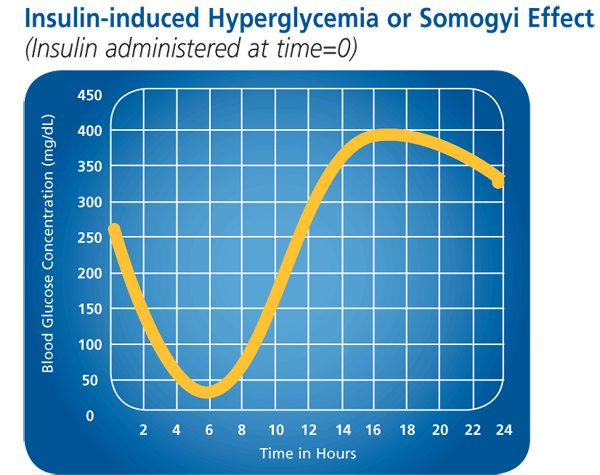

The Somogyi Effect
Read More About Monitoring & Controlling Feline Diabetes
Combating an Incorrect Insulin Dose
An important reason for conducting a blood glucose curve, ie, evaluating blood glucose levels every 2 hours following the morning Vetsulin® (porcine insulin zinc suspension) treatment is the possibility of Somogyi effect or rebound hyperglycemia.
In cats, the “Somogyi overswing” occurs when the insulin dose is too high and the patient’s blood glucose drops too quickly or plummets below 60 mg/dL.
The Somogyi effect occurs when the body attempts to counteract the life-threatening decline in the blood glucose concentration through a chain of reactions:
- The blood glucose concentration falls rapidly or approaches hypoglycemia (blood glucose concentrations of less than 60 mg/dL [3.3 mmol/L]) following the injection of insulin. The cat becomes hungry and restless or lethargic.
- In response to a declining blood glucose concentration in the central nervous system, adrenaline and subsequently cortisol, glucagons, and growth hormone are released.
- These hormones increase blood glucose concentration (through gluconeogenesis, release of glucose from hepatic glycogen, and increased peripheral resistance to insulin).
- The resulting hyperglycemia produces polyuria and polydipsia. This can be mistakenly attributed to an inadequate insulin dose.
If the morning polyuria is thought to result from an insufficient insulin dose and a higher dose is given, the problem will be aggravated. An even more pronounced Somogyi effect will follow. Eventually the counter-regulatory mechanisms may become exhausted, resulting in severe hypoglycemia.
The Somogyi effect can occur in both cats and dogs, but cats are particularly prone to develop this rebound hyperglycemia. The appropriate corrective action is to decrease the patient’s insulin dose to prevent insulin-induced hypoglycemia.
When to Suspect a Somogyi Overswing
- Minimal glycemia: <65 mg/dL or 3.6 mmol/L
- Maximum glycemia: 400–800 mg/dL or 22–44 mmol/L
- Persistent morning glucosuria: >1% or 1–2 g/dL (strips)
- Morning glycemia: >400–450 mg/dL or 22 mmol/L
- Clinical signs:
- Polyuria, polydipsia
- Absence of weight loss
- Hypoglycemia (weakness, convulsions, ataxia, behavior changes)
- High insulin dose: close to 2.2 IU/kg and greater
Diagnosing Somogyi Effect
A blood glucose curve can help detect a Somogyi effect and confirm that a cat’s insulin dose needs to be reduced.
Any of the following blood glucose curves can be suggestive of the Somogyi effect:
- Hypoglycemia (low nadir) followed by rebound hyperglycemia.
- A rapid decrease in glycemia with an adequate nadir followed by rebound hyperglycemia.
- Persistently high blood glucose values with no discernible nadir (rebound hyperglycemia can persist for a few days following the hypoglycemic event).
Blood Glucose Curve Indicating Somogyi Effect
See the following graph for an example of a blood glucose curve in a case of rebound hyperglycemia. Insulin was injected at time = 0 hours.
The solution is to decrease dose by 50% or return to starting dose of 1 IU twice daily, whichever is lower.
Blood glucose measured in mg/dL.

Resources to Help Clients Monitor Care
Help Your Practice Manage Diabetes Mellitus
Check out these tools and resources to help manage feline diabetes.

Blood Glucose Curve Generator
Create a blood glucose curve to monitor and evaluate diabetes treatments.

Client Discharge Form
Create a customized, printable form for clients about their new diagnosis.

Diabetes Resources
Access online tools and more to support staff and pet parents.
No items to show.
Read More About Monitoring & Controlling Feline Diabetes
Important Safety Information:
Vetsulin® should not be used in dogs known to have a systemic allergy to pork or pork products. Vetsulin is contraindicated during periods of hypoglycemia. Keep out of reach of children. As with all insulin products, careful patient monitoring for hypoglycemia and hyperglycemia is essential to attain and maintain adequate glycemic control and prevent associated complications. Overdosage can result in profound hypoglycemia and death. The safety and effectiveness of Vetsulin in puppies, breeding, pregnant, and lactating dogs has not been evaluated. See package insert for full information regarding contraindications, warnings, and precautions.
References:
1. Martin GJ, Rand JS. Pharmacology of a 40 IU/ml porcine lente insulin preparation in diabetic cats: findings during the first week and after 5 or 9 weeks of therapy. J Feline Med Surg. 2001;3(1):23–30. 2. Vetsulin® (porcine insulin zinc suspension) [Freedom of Information Summary]. Millsboro, DE: Intervet Inc.; 2008. 3. Data on file, Merck Animal Health. 4. Graham PA, Nash AS, McKellar QA. Pharmacokinetics of porcine insulin zinc suspension in diabetic dogs. J Small Anim Pract. 1997;38(10):434–438. 5. Martin GJ, Rand JS. Pharmacokinetic and Pharmacodynamic Study of Caninsulin in Cats with Diabetes Mellitus. 2000: Internal Study Report. 6. Feldman EC, Nelson RW. Canine and Feline Endocrinology and Reproduction. 3rd ed. St. Louis, MO: Saunders; 2004:539–579. 7. Tennant B, ed. BSAVA Small Animal Formulary. 4th ed. Gloucestershire, UK: British Small Animal Veterinary Association; 2002. 8. Feldman EC, Nelson RW. Canine and Feline Endocrinology and Reproduction. 3rd ed. St. Louis, MO: Saunders; 2004:486–538. 9. Reusch C. Feline diabetes mellitus. In: Ettinger SJ, Feldman EC, eds. Textbook of Veterinary Internal Medicine. 7th ed. St. Louis, MO: Saunders; 2010:1796–1816. 10. Nelson RW. Canine diabetes mellitus. In: Ettinger SJ, Feldman EC, eds. Textbook of Veterinary Internal Medicine. 7th ed. St. Louis, MO: Saunders; 2010:1782–1796. 11. Burgaud S, Riant S, Piau N. Comparative laboratory evaluation of dose delivery using a veterinary insulin pen. In: Proceedings of the WSAVA/FECAVA/BSAVA congress; 12–15 April 2012; Birmingham, UK. Abstract 121. 12. Burgaud S, Guillot R, Harnois-Milon G. Clinical evaluation of a veterinary insulin pen in diabetic dogs. In: Proceedings of the WSAVA/ FECAVA/BSAVA congress; 12–15 April 2012; Birmingham, UK. Abstract 122. 13. Burgaud S, Guillot R, Harnois-Milon G. Clinical evaluation of a veterinary insulin pen in diabetic cats. In: Proceedings of the WSAVA/FECAVA/BSAVA congress; 12–15 April 2012; Birmingham, UK. Abstract 45. 14. Davison LJ, Walding B, Herrtage ME, Catchpole B. Anti-insulin antibodies in diabetic dogs before and after treatment with different insulin preparations. J Vet Intern Med. 2008;22:1317-1325. 15. Banfield State of Pet Health 2016 Report. p 12-13.
